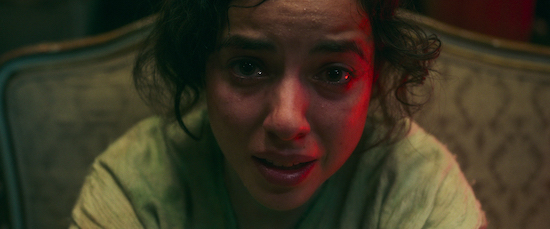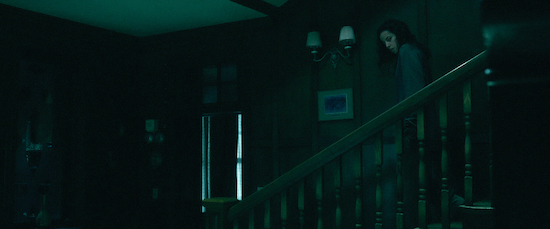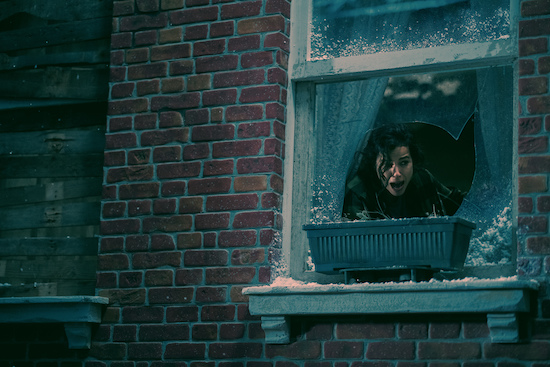NO ONE GETS OUT ALIVE. Cristina Rodlo as Ambar, in NO ONE GETS OUT ALIVE. Cr. Teddy Cavendish/Netflix © 2021
NB: Contains some spoilers for the Netflix adaptation of No One Gets Out Alive.
Given the current pitch-dark state of world events, you might be forgiven for thinking that horror could be in danger of going the way of satire and becoming redundant. The recent work of British author, Adam Nevill, suggests otherwise, however, with two projects realised in 2021 alone. Having exhibited an uncanny prescience with 2015s Lost Girl, in which a global coronavirus pandemic spreads from bat urine in a Chinese wet market against a backdrop of advanced climate change in 2053, Nevill’s two new projects concern the need for home and for territory. In his second Netflix adaptation, No One Gets Out Alive, an immigrant in search of the American dream finds herself stuck in a ghostly guesthouse from which escape seems impossible. In his new novel, Cunning Folk, a family of three move to a dilapidated countryside house they can barely afford, only to find themselves locked into a battle of wits with their eccentric but deceptively powerful neighbours.
The search for one’s home is an existential issue from which the essence of the uncanny itself could be said to spring. Sigmund Freud’s concept of The Uncanny, originally put forward in an essay of that name published in 1919, defines the feeling as “that class of the frightening which leads back to what is known of old and long familiar”. Drawing on the work of German philosopher F. W. J. Schelling, Freud comments that “the word Heimlich is not unambiguous but belongs to two sets of ideas … on the one hand what is familiar and agreeable [belonging to the house], and on the other, what is concealed and kept out of sight”. A similar ambiguity pertains to “the word canny – which can mean not only cosy but also ‘endowed with occult or magical powers’”.
For Freud, the quality of uncanniness stems from the recognition of something once felt at “a very early mental age, long since surmounted – a stage incidentally when it wore a more friendly aspect.” As for the notion of territory, I can think of no more emotive a definition than that from Russel Hoban’s marvellous existential fable, The Mouse And His Child: “A territory is your place… It’s where everything smells right. It’s where you know the runways and the hideouts, night or day. It’s what you fought for, or what your father fought for, and you feel all safe and strong there. It’s the place where, when you fight, you win.”
Santiago Menghini’s debut feature-length film, the Netflix adaptation of No One Gets Out Alive swaps suburban Birmingham for Cleveland Ohio – and the sexual exploitation subtext of the novel for the economic exploitation of its Mexican immigrant protagonist. There are some cultural details added (some subtle, some not so) that fit this change, but otherwise the feature remains largely faithful to the source material of the first part of the book. Cristina Rodlo, whom Nevill apparently wanted for the lead role after seeing her performance in Nicolas Winding Refn’s Too Old To Die Young, is spellbinding as Ambar, a hardworking immigrant tormented by the memory of her mother’s long illness and eventual death. Forced to take a room in a guesthouse due to a lack of other financially viable options, she wants nothing more than a shot at the American dream – something which seems increasingly unobtainable, as ghostly as some of the other residents of the guesthouse themselves. Exploited economically at the clothing factory she works long shifts at, and tricked by a fellow worker into handing over her meagre savings for a fake ID that never materialises, Ambar finds herself with no one else to turn to but her landlord Red (Marc Menchaca).

Both visually and thematically, Menghini’s film gets a lot right over its eighty-five-minute running time. The guesthouse is rendered with an incredible eye for detail. Recurring motifs, such as the moth that represents the Aztec goddess Ītzpāpālōtl (“God of Paradise made possible through sacrifice”), are finely interwoven in the tapestry of dread that emanates from the screen. Ambar’s inner strength and resilience – and her dark secret when it is finally revealed – provide her with an empowerment of sorts, but it is nevertheless a very difficult watch at times. Perhaps that is how it should be, given such subject matter. And given the film’s title, it should come as no surprise that there is no happy ending in store here.
The ending itself is fairly dense and appears initially ambiguous without consciously unpacking its use of symbols. Whilst it is clear that Ambar has indulged in vengeance against her captors, and could even be said to have switched the territory in which the battle takes place to something more akin to her own, given the graphic nature of the male on female violence, the film’s conclusion lacks the clear-cut resolution of a film such as Lucky McKee’s The Woman. McKee’s ‘Woman’ may be a cannibalistic barbarian, but she is still better parent material than the sadistic lawyer father.
The adaptation of No One Gets Out Alive suffers similarly to the adaptation of The Ritual (Nevill’s first Netflix-distributed film), in the truncation of a lengthy novel to the standard hour-and-a-half horror film length. In this case, however, with the subject matter being violence perpetrated by men against women, the lack of Nevill’s more sophisticated novelistic approach is more keenly felt. At over 600 pages, No One Gets Out Alive is one of Nevill’s longest books and contains a second section detailing the events that occur in the life of the protagonist after she has escaped the guesthouse, which throws an entirely different light on the difficult subject matter. Admittedly this is beyond the scope of most horror films, but although Menghini’s adaptation managed to fit a lot symbolically into its ending, it does make one wonder whether a limited mini-series might have told the story in a more satisfying – and more progressive – fashion.
Working in the opposite direction, beginning life as a screenplay and ending up as a novel after a three-year period of development and numerous rewrites, Cunning Folk, at almost 320 pages, is a leaner beast than most Nevill novels but in no sense suffers in any sense from a truncation of form. It even manages to cleverly play with the reader’s expectations of its characters and incorporate a kind of third act, though in a more subtle sense than No One Gets Out Alive or The Ritual. Nevill’s observations on the process in the afterword make for fascinating reading. He notes: “A screenplay can’t tell you how to write a novel. A screenplay is told visually, in pictures, with little dialogue; a novel is told within the inner life of its characters and you also need to paint the sets and do hair and makeup for the cast, and FX”. The novel also represents a slight change in tack for the author in that there are both comic and cosmic elements at play.
Focusing a horror novel on the subject of bad neighbours is a move that offers plenty of scope and, I would wager, the chance of a near universal sense of recognition amongst readers. It is surprising that there aren’t more novels in the genre exploring the subject. Ira Levin’s Rosemary’s Baby is a classic example but after that, I struggle to come up with many notable ones. Even if one’s neighbours aren’t actually evil, from the petty disputes that can arise, or even matters simply to do with the closeness of living quarters in big cities that are of no fault of either party, there is a lot in Cunning Folk that will resonate with readers’ own experiences of the people next door.

From the onset, the terms in which the opposing sides are described seem unambiguous. The relatively clean-cut family, Tom, Fi, and their young daughter Gracey, are basically good people aspiring to own a home – figures most people can identify with. Their neighbours, the Moots, appear aloof and antagonistic but the level of threat they represent is initially obscured by their apparent age and eccentricity. By allowing the reader to see through both Gracey’s unfiltered, childlike perceptions and Tom’s more realistic, adult viewpoint, the journey that Tom makes, initially questioning events that don’t fit in with his established worldview, appears all the more profound.
As Adam Nevill said to the Quietus via email: “I’d say Tom’s journey and involvement with what is at the heart of the magic, is pretty deep. He goes all the way.” Again, this aligns well with Freud’s notion of ‘the uncanny’, yet it also reveals some flaws in the theory. Really what Freud is talking about are the limits of our systems of thought and experiences, or ideas that don’t fit in with those systems, which perhaps do pertain in some respect to childhood states where language and logic are not so well constructed and relied upon as to seem to us the entire world. Freud clings to the value of his linguistic and logical systems as if they were the only reality. Perhaps this isn’t surprising, given that Freud was attempting to create a science and felt that to do so he had to banish superstition in order to do so. As later developments in both quantum physics and anthropology have stressed however, it is wise to question the cultural bias of one’s own learned assumptions, lest we fall into the trap of believing them to be objectively true.
This is precisely the kind of journey that Tom is forced to take during the course of the novel. Following our initial identification with Tom’s anger against the Moots, it seems as if Tom and Fi become solely defined by their desire to get on the housing ladder. At times there isn’t much room for them to be anything other than that. The Moots, and Tom’s potential ‘saviour’ Blackwood (named after the prolific English ghost story writer, Algernon Blackwood), are meanwhile described in the usual kind of genre clichés connecting the idea of those who use occult power as being ageing, decrepit, diseased, perverted, etc. At this point, my faith in where the narrative was headed began to waver somewhat and Tom’s motives started to appear questionable. Was he really the aggressor in this situation? Perhaps he was crazy and imagining at least some of these events. This kind of subtle manipulation of the reader’s expectation is the mark of a real master. The reader, too, is forced to undergo the same journey as Tom. Where it finally ended up was somewhere I honestly could not have foreseen.
Sounding out Nevill on his own attitudes towards the magic in the book, he wrote via email: “I’m not an evangelist for practicing magic, nor its existence. But nor do I dislike it or disapprove of it. I think occult magic is a fascinating system for making sense of causation. The later twentieth-century philosophies and concepts around magic, to my eye, offer systems of measuring balance and correcting imbalance, in almost everything. Because that’s the thing with magic – everything can be seen in magical terms, or nothing. What you use to measure your own reality is a matter of choice or temperament. I don’t deride it as it must be a vast source of comfort and empowerment for some people. But I detest its abuse, as I detest the abuse of organised religion and power.
“The more I read about magic, psychoanalytic perspectives don’t appear too dissimilar – how you think determines how you feel, ultimately. You can apply techniques into an ongoing, perhaps endless, search for meaning, for enlightenment about yourself and place among other people. The goal is balance, a happier more reasonable existence. Magic to my eye, does something similar.”
If magic is concerned with making external transformations in accordance with the individual will, then mysticism is concerned with uniting the will and the emotions in an effort to transcend the world of the senses and such desires as magic seeks to fulfil. Although in his afterword, Nevill expresses the feeling that the book may still one day make “a cracking little horror film”, in my view it would take a very skilful director indeed to capture the subtle essence of such exquisitely written passages as those dealing with Tom’s mystical visions. According to Nevill: “These passages, or atmospheres, arise from the maelstrom in my imagination when it’s been transported by what I’m writing. I go to the same place mentally as when I am genuinely in awe of the sea and nature; when I feel my consciousness change and operate differently. I wouldn’t write without this facility. It’s why I began writing. And why I spend so much time outdoors. From this kind of day dreaming comes the mystical elements in the stories.
“I think what I am currently striving for, is the sense of something vaster, more cosmic, at the edge of comprehension. Not indifferent to us so much as unaware, that coexists unless roused. It might be holy, alien, beyond our grasp of physics. It’s neither malign, nor righteous. It exists in some way and utterly dwarfs us. We’ll signify it in all manner of ways but will never fully grasp what it is. It remains ineffable. We only scratch the surface with great leaps of imagination. It’s what I treasure about [Arthur] Machen and Blackwood. This mystical enigma is worth keeping alive in fiction. I’ve always strived for it.”
It is these qualities which keep Adam Nevill’s work at the very top of the horror genre. Whilst the two films that exist of his work are both excellent in their own way, and truly frightening as horror films should be, Nevill’s unique strengths as a writer are continuing to evolve in a way that may never be adequately captured via the cinematic medium. According to Freud “people vary so very greatly in their sensitivity to this quality of feeling… It is long since [the writer of this present contribution] has experienced or heard of anything which has given him an uncanny impression”. Thankfully, both for his readers and for his own technique as a horror author, Adam Nevill is more finely attuned to such feelings. Capable of evoking them with deceptive ease, Nevill’s fiction also conveys more complex and subtle realities than one which looks scornfully upon “our primitive forefathers [who] once believed that these possibilities were realities, and were convinced that they actually happened”. Tom’s journey in Cunning Folk, which the reader undertakes with him, may not take him to a happy place, but it does peer behind the curtain of his limited worldview, past the stirrings of the uncanny as described by Freud and into the ineffable space beyond.


